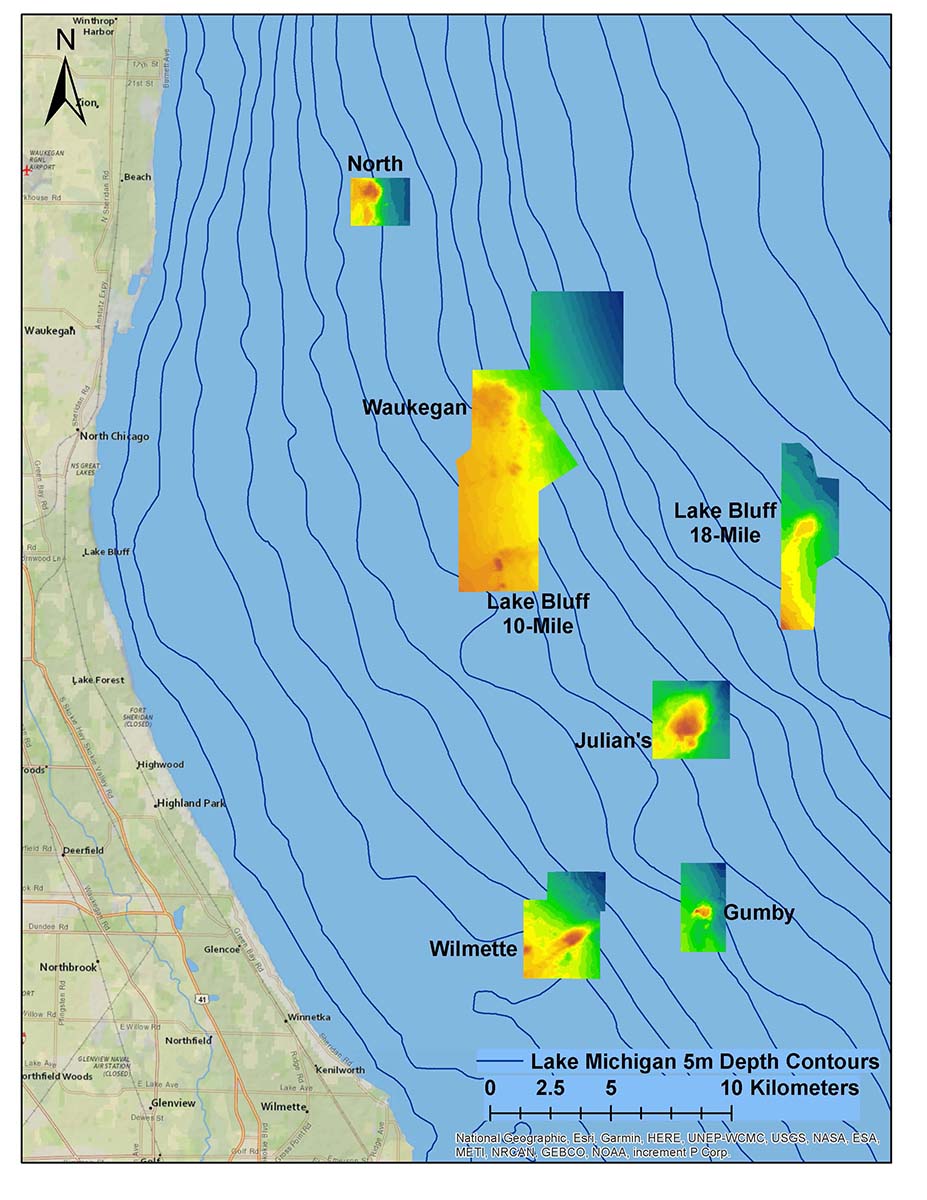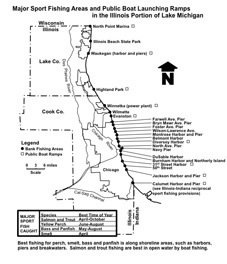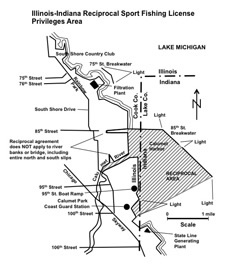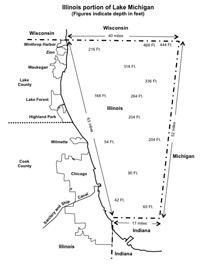Lake Michigan
Lake Michigan offers anglers a variety of experiences from shore fishing in the bustling harbors and lagoons of Chicago to launching a day's adventure from one of many marinas. Whether you seek a tasty meal of yellow perch or the excitement of landing a chinook salmon on a day charter, Lake Michigan is a true destination for the Illinois Angler.
Harbors
Many species of sport fish are found in Chicago harbors throughout the year and others only inhabit harbors during certain times of the year. The Chicago Park District has designated certain areas of these harbors open to anglers fishing from shore.
Marinas
| Marina | Location | Operator | Capacity | Services | Fee | Restrictions |
|---|---|---|---|---|---|---|
| North Point Marina | 7th Street in Winthrop Harbor, IL | Westrec Marinas (847) 746-2845 |
10 boat launching lanes 200 parking spaces for car and trailer |
|
$10 public launch | Ramp is open 24hrs April 1 to October 31, weather permitting |
| The Port of Waukegan (Waukegan Harbor) | Harbor Place, Waukegan, IL | Waukegan Port Authority (847) 244-3133 |
4 boat launching lanes 600 parking spaces for car and trailer |
|
$10 (daily parking) $20 (public launch) Call for slip pricing |
Ramp is open 24hrs April 1 to November 1, weather permitting |
| Park Avenue Launch Ramp | Park Avenue in Highland Park | Highland Park District (847) 831-3810 |
1 boat launching lanes 25 parking spaces for car and trailer |
|
$15 (resident daily launch M-F/$35 weekend) $10 (resident beach launch/$20 weekend) Nonresident fees are double the rate of resident fees. |
Ramp is open April 1 to October 15 Hours: 7 AM to 9PM; not staffed after Labor Day Site has no dockage stalls or mooring buoys |
| Lloyd Park in Winnetka | Lloyd Place in Winnetka | Winnetka Park District (847) 501-2040 |
1 boat launching lanes 63 parking spaces for car and trailer |
|
$15 (resident daily launch M-F/$35 weekend) $5 (resident beach launch/$15 weekend) Nonresident fees are double the rate of resident fees. |
Ramp is open May 1 to October 15 Hours: 8 AM to dusk (M-F); 7 AM to 9 PM (weekend) Site has no dockage stalls or mooring buoys Maximum boat length 25 feet |
| Evanston Launch Ramp | Church Street in Evanston | City of Evanston (847) 448-4311 |
2 boat launching lanes 20 parking spaces for car and trailer |
|
$250 resident seasonal only $500 nonresident seasonal only Seasonal launch permits on sale starting April 1 |
Ramp is open May 1 to October 31 Hours: 7 AM to 10 PM Call regarding further restrictions |
| Diversey Harbor in Lincoln Park | Diversey Parkway (2800 North), Chicago | Chicago Park District (312) 742-7762 |
3 boat launching lanes 60 parking spaces for car and trailer |
|
$26 (daily) | Ramp is open May 1 to October 31 No launching after 8 PM Maximum boat length 23 feet |
| Burnham Harbor in Burnham Park and Northerly Island | 12th Street (1200 South), Chicago | Chicago Park District (312) 747-7009 |
3 boat launching lanes on west side 37 parking spaces for car and trailer on west side |
|
$26 (daily) | Ramp is open May 1 to October 31 No launching after 8 PM Maximum boat length 23 feet |
| 31st Street Harbor | 3100 South, Chicago | Chicago Park District (312) 225-6464 |
2 boat launching lanes 12 parking spaces for car and trailer on west side |
|
$26 (daily) | Ramp is open May 1 to October 31 No launching after 8 PM Maximum boat length 30 feet |
| Jackson Harbor in Jackson Park | Hayes Drive (6300 South), Chicago | Chicago Park District (773) 288-7106 |
2 boat launching lanes on east side 80 parking spaces for car and trailer on east side |
|
$26 (daily) | Ramp is open May 1 to October 31 No launching after 8 PM Maximum boat length 23 feet |
| Calumet Harbor | 95th Street, Calument Park, Chicago | Chicago Park District (312) 742-8520 |
3 boat launching lanes on east side 100 parking spaces for car and trailer on east side |
|
$26 (daily) | Ramp is open all year No launching after 8 PM Maximum boat length 23 feet Site has no dockage stalls or mooring buoys |
There were 21 tournaments held on this waterbody in 2024.
| Species | Total Fish Caught |
| Chinook Salmon | 202 |
| Coho Salmon | 623 |
| Lake Trout | 288 |
| Rainbow Trout | 92 |
| Smallmouth Bass | 309 |
Fish Species in the Illinois Waters of Lake Michigan
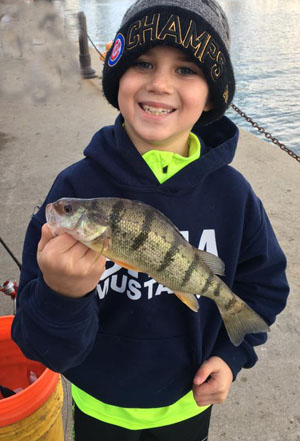 Perch Fishing: Open all year except from May 1 – June 15
Perch Fishing: Open all year except from May 1 – June 15
The bag limit is 15. Best place to fish are found along breakwalls and piers that drop off into deep (12 to 20 feet) water. Softshell crayfish, spikes, minnows, spinners and jigs are all great baits to use for perch.
- January – February
Lakefront and Harbors: Perch, Panfish and Trout - March – April
Lakefront and Harbors: Coho Salmon and Smelt
Lagoons: Early season Bluegill and Crappie - May – August
Lakefront and Harbors: Perch (except for closed season May 1 - June 15), Panfish, Carp and Smallmouth Bass, Freshwater Drum (aka Sheephead, Silver Bass)
Lagoons: Bluegill, Channel Catfish and Largemouth Bass
Channel catfish (12,500+ fish) and bluegill (56,000+ fish) are stocked by the IDNR in the following lagoons in June, July, and August: Auburn, Columbus, Douglas, Garfield, Gompers, Humboldt, Jackson, Marquette, McKinley, Sherman, and Washington. Crappie, largemouth bass and carp can be found too. - September – December
Lakefront and Harbors: King and Coho Salmon, Brown Troud, Steelhead and Perch, Freshwater Drum
Lagoons: Bluegill and channel Catfish (mainly in September and October)
Lake Michigan Smelt Fishing

Rainbow smelt (Osmerus mordax) are a naturalized exotic in Lake Michigan. Originally transported from the east coast and stocked in Crystal Lake, Michigan, smelt were first reported in Lake Michigan in 1923. The smelt population expanded and reached high levels by the early 1940s.
Smelt begin spawning in Lake Michigan as early as March 17 or as late as April 28. The peak of the run, and the best fishing, lasts about a week, usually starting between April 10 and 20. Regulations for smelt fishing apply to the type of equipment used; there are not bag limit or length restrictions. The smelt fishing season is March 1 through April 30.
An Illinois sport fishing license is required to fish for smelt. The best places to fish for smelt are along the Chicago Park District property and at beaches from Waukegan to the Illinois-Wisconsin state line.
Find the latest updates here:
- Chicagoland Fishing - forums with daily updates
Smelt Fishing Gear
A gill net made of nylon thread is the most common type of gear used in Illinois. Threads are from ½ to ¾ inch apart in a crisscross manner and legally must not exceed 1 ½ inches diagonal stretch. There are floats on the top line and lead weights on the bottom line. the net forms a fence-like obstruction in the water and when smelt try to swim through, they become entangled. Some special equipment is required to maneuver the net in and out of the water. A one to two pound anchor, which has flexible wire extensions that grab the bottom, is attached to a heavy line and thrown our 50 to 100 feet from shore. This line is pulled as tight as possible, without loosening the anchor, and then tied to a pole, pier railing, or other stationary object. A line of about 25 feet is fastened to the back of the net and the other end of this line is secured to the shore. A trolley, which is a one half to one pound weight suspended below two wheels, is tied to the forward end of the net and then attached t the anchor line. The bet line is used to pull in the net and the trolley rides up the anchor line. Most fishermen raise their nets every 5 to 10 minutes. Gill nets up to 12 feet long and 6 feet deep may be used legally, and an angler is limited to one smelt fishing device at any one time.
A large dip net or boom net, up to 12 feet in diameter, is another smelt fishing device. Mesh size may not be less than one inch diagonal stretch. It is suspended from the top of a portable boom which is tilted to hang over the water. The net is lowered into and raised out of the water by a rope or cable attached to a winch. Smelt are removed by a long-handled scoop.
A seine is still another type of gear used for smelt fishing. It
is used on the beaches and is pulled through the water by two persons
who usually wear waders or hip boots. When smelt are running heavy,
one seine haul will provide enough fish to fill a minnow bucket.
the mesh of a seine is made of nylon, either woven or knotted, and
is 1/8 or ¼ inch square. A legal smelt seine may not exceed
12 ft in length and 6 ft in depth and may not have mesh greater
than 1 ½ inches diagonal mesh stretch. All fish other than
smelt taken in smelt fishing devices must be immediately returned
to the water.
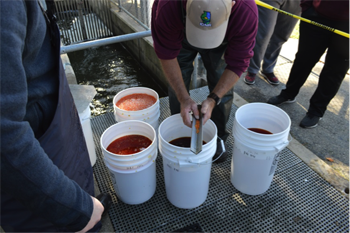 Lake Michigan Salmon and Trout Stocking
Lake Michigan Salmon and Trout Stocking
Chinook Salmon, Coho Salmon, Brown Trout and two strains of Rainbow Trout are raised at the Department's Jake Wolf Memorial Fish Hatchery in downstate Illinois (Manito). Chinook Salmon eggs are typically collected from mature fish in the Little Manistee River (Michigan) by Illinois and Michigan Departments of Natural Resources personnel; Coho Salmon eggs are collected from mature fish in the Platte River (Michigan). Eyed eggs (developed to the point that eyes can be distinguished inside the egg) of Brown Trout and Arlee-strain Rainbow Trout are received from US Fish & Wildlife Federal hatcheries, and fertilized Skamania-strain Rainbow Trout eggs are received from an Indiana Department of Natural Resources hatchery.
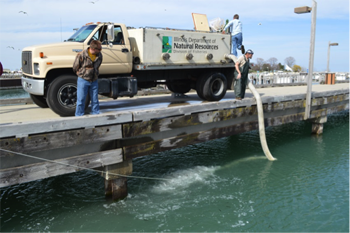 The eggs are incubated at Jake Wolf and surviving fry are reared in indoor tanks and outdoor raceways until they reach a stocking size of about 5 inches. The advanced fingerlings are transported to Lake Michigan and stocked by hatchery staff in early or late summer, depending on the species. Lake Trout stocked in Illinois waters are hatched and raised at one of the US Fish & Wildlife Service Federal hatcheries. These fish are then stocked offshore as yearlings with the Service's stocking vessel M/V Spencer F. Baird.
The eggs are incubated at Jake Wolf and surviving fry are reared in indoor tanks and outdoor raceways until they reach a stocking size of about 5 inches. The advanced fingerlings are transported to Lake Michigan and stocked by hatchery staff in early or late summer, depending on the species. Lake Trout stocked in Illinois waters are hatched and raised at one of the US Fish & Wildlife Service Federal hatcheries. These fish are then stocked offshore as yearlings with the Service's stocking vessel M/V Spencer F. Baird.
 There have been several studies over the years that have required us to be able to identify the age, strain, or stocking location of salmon and trout stocked in our waters. A highly visible and relatively inexpensive method of marking fish is to clip off one or a combination of fins. One ongoing Illinois project involves clipping fins on Coho Salmon stocked in Waukegan and Diversey harbors to assess fall spawning returns to each stocking site. Fin clips differ between harbors and clipped fish are stocked in each harbor during alternate years, allowing differential return rates to be determined for each of the harbors.
There have been several studies over the years that have required us to be able to identify the age, strain, or stocking location of salmon and trout stocked in our waters. A highly visible and relatively inexpensive method of marking fish is to clip off one or a combination of fins. One ongoing Illinois project involves clipping fins on Coho Salmon stocked in Waukegan and Diversey harbors to assess fall spawning returns to each stocking site. Fin clips differ between harbors and clipped fish are stocked in each harbor during alternate years, allowing differential return rates to be determined for each of the harbors.
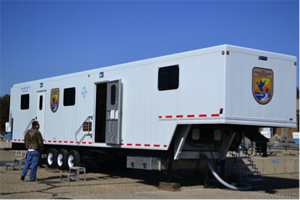 Illinois also participates in the Mass Marking Project that occurs in Lakes Michigan and Huron. In partnership with the US Fish and Wildlife Service, the IDNR and other State agencies began marking all stocked Chinook Salmon with an adipose fin clip and coded-wire tag in 2010. An automated tagging trailer is used to insert coded-wire tags into the snouts of Chinook Salmon smolts, enabling researchers to determine stocking site fidelity, movements, and survival of stocked fish and the proportion of naturally spawned fish in the population. Stocked Chinook Salmon received coded-wire tags from 2010 through 2016, after which the study shifted to tagging all stocked Rainbow Trout in both lakes. Lake Trout have received coded-wire tags for several years now and, like Chinook Salmon and Rainbow Trout, much of the same information can be collected from tag returns, along with additional information on the strain and source location of tagged Lake Trout.
Illinois also participates in the Mass Marking Project that occurs in Lakes Michigan and Huron. In partnership with the US Fish and Wildlife Service, the IDNR and other State agencies began marking all stocked Chinook Salmon with an adipose fin clip and coded-wire tag in 2010. An automated tagging trailer is used to insert coded-wire tags into the snouts of Chinook Salmon smolts, enabling researchers to determine stocking site fidelity, movements, and survival of stocked fish and the proportion of naturally spawned fish in the population. Stocked Chinook Salmon received coded-wire tags from 2010 through 2016, after which the study shifted to tagging all stocked Rainbow Trout in both lakes. Lake Trout have received coded-wire tags for several years now and, like Chinook Salmon and Rainbow Trout, much of the same information can be collected from tag returns, along with additional information on the strain and source location of tagged Lake Trout.
Annual Stocking Reports
2023 Stocking Report
2022 Stocking Report
2021 Stocking Report
2020 Stocking Report
2019 Stocking Report
2018 Stocking Report
2017 Stocking Report
2016 Stocking Report
2015 Stocking Report
2014 Stocking Report
2013 Stocking Report
2012 Stocking Report
2011 Stocking Report
2010 Stocking Report
2009 Stocking Report
2008 Stocking Report
2007 Stocking Report
2006 Stocking Report
2005 Stocking Report
2004 Stocking Report
2003 Stocking Report
Spring Index Survey
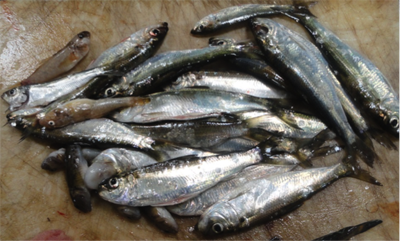 Alewife, Round Goby, Rainbow Smelt and Bloater (chubs) are the primary forage fish for Lake Michigan predators. The overall objective of the spring index survey, started in 1987, is to assess the population status of these forage fish. Knowing population characteristics of forage species is important because they all reproduce naturally in the lake, while the salmon and trout predator populations are largely maintained through stocking. Identifying changes in the abundance of forage fish helps to determine if changes in stocking rates of salmon and trout are necessary to prevent overtaxing or underutilizing the food supply.
Alewife, Round Goby, Rainbow Smelt and Bloater (chubs) are the primary forage fish for Lake Michigan predators. The overall objective of the spring index survey, started in 1987, is to assess the population status of these forage fish. Knowing population characteristics of forage species is important because they all reproduce naturally in the lake, while the salmon and trout predator populations are largely maintained through stocking. Identifying changes in the abundance of forage fish helps to determine if changes in stocking rates of salmon and trout are necessary to prevent overtaxing or underutilizing the food supply.
Program biologists sample with gill nets set at several depths, covering the shallow water areas close to shore out to 270 feet. Sampling occurs annually near Waukegan and Chicago during spring. These two sampling areas were chosen because they differ in water depths resulting in differences in fish species abundance and composition. Sampled fish are counted, measured, and weighed. Sex and maturation (e.g., egg development) are also assessed, and otoliths are collected to determine ages. This survey also provides additional information on Yellow Perch and Lake Trout populations.
The objectives of spring index sampling are to:
- Monitor changes in the relative abundance of forage fish between years
- Monitor growth indices and population sex ratios
- Collect age-composition data to determine recruitment rates
Yellow Perch Survey
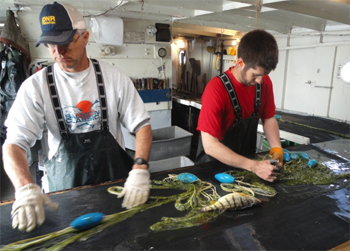
Yellow Perch abundance in the Illinois waters of Lake Michigan has varied greatly over the past few decades. Gill net assessments conducted annually since 1976 by the Illinois Department of Natural Resources show that the high population levels of the 1980s have now declined to historic lows. The relatively recent additions of zebra and quagga mussels and the Round Goby to Lake Michigan have altered the environment in which Yellow Perch thrived in the past. The changes induced by these invasive species require managers to continuously monitor Yellow Perch population levels and assess protective measures to sustain the population.
Program biologists sample adult Yellow Perch annually with gill nets at Lake Bluff and Chicago (Foster Avenue) in late spring. Sampled fish are counted, measured, and weighed. Sex and maturation (e.g., egg development) are also assessed and otoliths are collected to determine ages. In addition, juvenile Yellow Perch are sampled with a beach seine at five sites covering the Illinois shoreline. These small perch are counted and measured, and the abundance of the newly hatched perch, also referred to as young-of-year fish, is used as an indicator of whether the adult population is likely to increase or decrease in the future.
The objectives of yellow perch sampling are to:
- Monitor changes in the relative abundance of Yellow Perch across years
- Monitor growth and the population sex ratio for Yellow Perch
- Collect age-composition data to determine year class strength
- Evaluate anticipated recruitment through estimates of young-of-year abundance
Summer Harbor Assessment

Several sport and non-sport fish species inhabit Illinois harbors and nearshore areas of Lake Michigan in summer. Concurrent with the decline of the Yellow Perch fishery is an increasing demand for other sportfishing opportunities in nearshore areas and an increased interest in the nearshore sport fishery, especially for Largemouth Bass and Smallmouth Bass. Increases in the abundances of these warm-water fish species and angler effort for non-perch and non-salmonid fish species in the Illinois waters of Lake Michigan are evident from sport angler creel data.
The summer harbor assessment was developed to monitor the relative abundance and distribution of nearshore sport fish species and to determine whether those species were susceptible to overexploitation by tracking changes in relative abundance over time. In addition to biological information (e.g., length and weight), an understanding of seasonal dispersal patterns of the sport fish associated with the nearshore fish community is required to effectively manage these species.
Program biologists sample four harbors by electrofishing to determine which species are present and available to anglers in nearshore areas during summer. Sampled fish are counted, measured, and weighed. Subsamples of those fish are collected to determine ages.
The objectives of the summer harbor sampling are to:
- Determine fish species composition of select Illinois harbors and nearshore areas of Lake Michigan
- Monitor changes in the relative abundances of Smallmouth Bass and Largemouth Bass and other sport fish between years
- Monitor growth rates for Smallmouth Bass, Largemouth Bass and Rock Bass inhabiting Illinois harbors
- Collect age-composition data that may eventually be used to determine recruitment rates of the most abundant fish species
Summer 2024 Harbor Annual Report
Fall Harbor Assessment
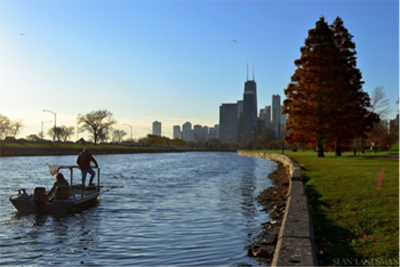
Coho Salmon were first stocked in Illinois waters in 1976 and salmon and trout stocking in Illinois currently accounts for approximately 8% of the lakewide stockings. The Illinois annual stocking plan includes 150,000 Chinook Salmon, 300,000 Coho Salmon, 110,000 Rainbow Trout, 110,000 Brown Trout, and 120,000 Lake Trout.
Program biologists sample four harbors by electrofishing to determine the abundance of salmon and trout in Illinois harbors in the fall. Sampled fish are counted, measured, and weighed. Sex and maturation (e.g., egg development) and Sea Lamprey wounding rates are also assessed, and otoliths are collected from Chinook salmon to determine ages. The return rate of salmonids to the harbors in which they are stocked is evaluated by marking stocked fish with a coded-wire tag or by clipping off different fins in different years. Fish tissue samples are also collected to update fish consumption advisories.
The objectives of the fall salmonid harbor sampling are to:
- Collect fish flesh samples to update the Illinois Fish Consumption Advisory
- Collect data on returning marked fish and assess movements and fidelity to stocking sites
- Collect information on the condition and abundance of returning fish to address questions regarding health of the fish and the effects on the forage base
Fall 2020 Harbor Annual Report
Spring Lake Trout Survey
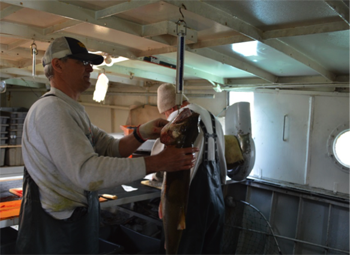
Management of the Lake Michigan fish community is the shared responsibility of the four states surrounding the lake and the Chippewa/Ottawa Resource Authority (CORA). Previously, each state group assessed species health and abundance in its waters independently and by different methods. There was little coordination among agencies and interpretation of data from the different sources was difficult. A move to standardize sampling in the late 1990s led to development of a lakewide coordinated Lake Trout survey conducted during spring.
Program biologists sample adult Lake Trout with gill nets near Waukegan each spring. Sampled fish are counted, measured, and weighed. Sex and maturation (e.g., egg development) are also assessed. Otoliths are collected to determine ages and stomachs are collected to determine diet composition. Indicators of fish health are also assessed including: fat content, condition of various internal organs, and proportion of weight to length. The incidence of Sea Lamprey wounds and scars is recorded, and fin clips and coded wire tags are used to determine where and when the Lake Trout were stocked.
Lakewide assessment results are presented in annual and multi-year reports prepared jointly by biologists representing each management agency on Lake Michigan.
The objectives of spring Lake Trout sampling are to:
- Determine growth, population mortality, and natural recruitment of the Lake Trout population
- Assess the health status of the population
Fall Lake Trout Survey
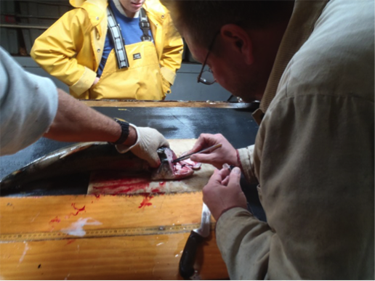
Lake Trout was historically the top predator in Lake Michigan and supported the largest harvest of the Great Lakes. Lake Trout were extirpated from Lake Michigan by the 1950s due to overharvest, habitat degradation and predation by the invasive Sea Lamprey. Stockings of Lake Trout began in 1965 to reestablish populations in the lake. Rehabilitation has involved controlling Sea Lamprey, determining appropriate strains of Lake Trout to stock and managing harvest and further impairments to fish habitat. A primary objective of the Lake Michigan Fish Community Objectives is to "establish a self-sustaining Lake Trout population, able to yield an annual harvest projected conservatively at 2.5 million pounds." The achievement of this objective relies on natural reproduction of Lake Trout.
Program biologists sample adult Lake Trout with gill nets at historic spawning reefs and other reefs with similar habitat in late fall. Sampled fish are counted, measured, and weighed. The incidence of Sea Lamprey wounds and scars is recorded, and fin clips and coded wire tags are used to determine where and when the fish were stocked. Sex and maturation (e.g., egg development) are also assessed. Otoliths are collected to determine ages.
The objectives of fall Lake Trout sampling are to:
- Monitor changes in the relative abundance of spawning aggregations of Lake Trout between years
- Monitor growth indices and population sex ratios
- Collect age-composition data
- Identify which stocked strains contribute to the spawner stock
- Evaluate mortality due to Sea Lamprey predation
Spring and Fall 2023 Trout Assessments
Charter Boat Harvest Monitoring
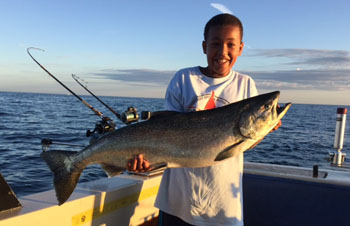
Non-native salmon and trout have become an integral part of the Lake Michigan fish community and the sport fishery. Pacific salmon and various trout species have been stocked in Lake Michigan since the late 1960s. The purposes of stocking these fish are to re-establish self-sustaining Lake Trout populations, control Alewife population growth and provide quality sport fishing opportunities.
Charter boat operators receive a fee to provide sport anglers access to offshore fishing opportunities for Lake Michigan salmon and trout. A catch (harvest) reporting system is mandated through Illinois statutes governing charter boat licensees that engage in such activities in Illinois waters (Fish Code of Illinois, Section 5/10-135). Charter boat operators submit monthly reports detailing the number of fish harvested, number of anglers and amount of time spent fishing, and general location information. These harvest and effort data are vital to understanding the abundance of salmon and trout predators and their effects on prey fish populations.
Charter Boat Annual Reports (PDF)
2024 Charter Fishery Report
2023 Charter Fishery Report
2022 Charter Fishery Report
2021 Charter Fishery Report
2020 Charter Fishery Report
2019 Charter Fishery Report
2018 Charter Fishery Report
2017 Charter Fishery Report
2016 Charter Fishery Report
2015 Charter Fishery Report
2014 Charter Fishery Report
2013 Charter Fishery Report
2012 Charter Fishery Report
2011 Charter Fishery Report
2010 Charter Fishery Report
2009 Charter Fishery Report
2008 Charter Fishery Report
2007 Charter Fishery Report
2006 Charter Fishery Report
Habitat Mapping

In simplest terms, habitat is the natural environment where fish live, and it is defined by where they can find food, shelter, and breeding grounds. In the Great Lakes, fish habitat has been degraded or fragmented in many coastal areas with the hardening of shorelines and loss of "run of the river" due to dams. Both nearshore and offshore areas of Lake Michigan also provide important habitat for many fishes. For example, Yellow Perch prefer to spawn in areas with vegetation or hard substrate, while Lake Trout primarily spawn on rocky reefs. These in-lake habitats have also been degraded, directly and indirectly, by invasive zebra and quagga mussels. In order to rehabilitate essential fish habitat and minimize impacts from future disturbances, fisheries managers must first know what habitat is available and how it is being utilized by fish. One approach to documenting fish habitat is to identify areas inhabited by fish, then conduct surveys on those areas to quantify the bathymetry (depth and shape of underwater terrain) and bottom substrate characteristics of those areas. From there, the data is used to generate maps of potential fish habitat. Once the preferred habitat characteristics have been identified, they can be used to look for other areas that may be crucial for specific life stages of fish. This approach is currently being used to map Lake Trout spawning habitat in Illinois waters of Lake Michigan through a collaborative project with the Illinois Natural History Survey (INHS).

Lake Trout stocking in Lake Michigan has been ongoing since the 1960s, and until recently, has had only limited success in re-establishing naturally reproducing populations. Successful Lake Trout reproduction to the fry stage has been documented for the past two years at Julian's Reef, an historic offshore spawning site in southwestern Lake Michigan. Additionally, annual population monitoring by Illinois DNR during the fall spawning season has shown high abundances of mature Lake Trout at Julian's and Waukegan reefs, and since 2012, 40% or more of those adult Lake Trout were of natural origin. (Please read:Progress Toward Lake Trout Rehabilitation). This is the highest proportion of naturally-produced Lake Trout documented by state management agencies around Lake Michigan. These findings imply that natural reproduction is occurring in Illinois waters and have prompted the need to identify and map additional potential spawning habitat within the Illinois portion of the lake.
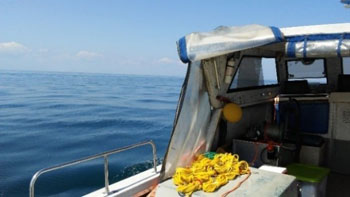
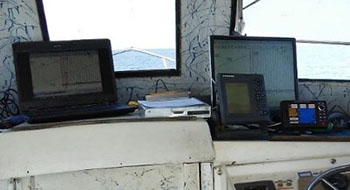
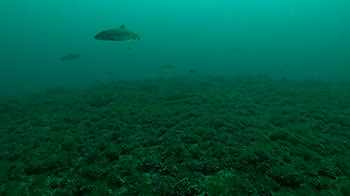
In 2009–2011, researchers with INHS's Lake Michigan Biological Station began the mapping process for Waukegan and Julian's reefs. (Please read:Lake Trout Spawning Habitat). Aboard the RV Sculpin, an echo sounder and GPS were used to develop bathymetry maps and a hydroacoustic towfish was deployed to produce side-scan images of bottom substrate types. A drop camera was then used to confirm substrate types. More recently, bathymetry mapping has been occurring at other offshore reefs (see list below) in Illinois waters where Lake Trout might also be spawning. The geo-referenced, bathymetric maps created from this ongoing work will aid DNR in finding other potential spawning habitat for Lake Michigan's top native predator. Potential outcomes from this work include a better understanding of Lake Trout populations in the lake's southern basin and identification of priority management areas that may be suitable for future habitat protection or rehabilitation projects.
This research is an ongoing collaborative study between the Illinois Natural History Survey and the Illinois Department of Natural Resources. Funding for mapping activities is from the Great Lakes Fish and Wildlife Restoration Act and Federal Aid in Sport Fish Restoration projects F-123-R, F-65-R and F-196-R.
Habitat Maps
Currently available are maps of:
Gumby Reef (Meters, Feet, 3D)
Julian's Reef (Meters, Feet, 3D)
North Reef (Meters, Feet, 3D)
Lake Bluff 10-Mile Reef (Meters, Feet, 3D)
Lake Bluff 18-Mile Reef (Meters, Feet, 3D)
Waukegan Reef (Meters, Feet, 3D)
Wilmette Reef (Meters, Feet, 3D)
You can see their relative locations on the map below. Click on the reef for an in-depth map with bathymetry. Note that colored depth scales are different for each map.
